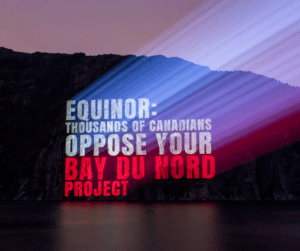Equinor, Cancel Bay du Nord
The Equinor Bay du Nord project would be a disaster for our climate and could cause serious oil spills if built. Hundreds of people have protested against Equinor’s Bay du Nord in St. John’s, Newfoundand and Labrador. There have been many other demonstrations both in the province Newfoundland and Labrador and across Canada against Bay du Nord and over 126 environmental and citizen’s groups and academics from NL and the rest of Canada also oppose the project.
 Sierra Club Canada is also part of a legal challenge against Bay du Nord being approved by the Canadian government. That court case also includes the Indigenous group Mi’gmawe’l Tplu’taqnn Incorporated (MTI) which represents eight Mi’gmaq communities in New Brunswick.
Sierra Club Canada is also part of a legal challenge against Bay du Nord being approved by the Canadian government. That court case also includes the Indigenous group Mi’gmawe’l Tplu’taqnn Incorporated (MTI) which represents eight Mi’gmaq communities in New Brunswick.
Bay du Nord is a Bad Economic Choice for Equinor
It’s also incredibly risky economically as a project. Earlier this year Equinor’s stock was downgraded due in part to continued consideration of Bay du Nord.
 ABG Sundal Collier’s downgrading of the Equinor stock shocked the market, and later this year further research showed Bay du Nord to be ‘too costly for shareholders.’ More information about the downgrading of Equinor stock can be found here.
ABG Sundal Collier’s downgrading of the Equinor stock shocked the market, and later this year further research showed Bay du Nord to be ‘too costly for shareholders.’ More information about the downgrading of Equinor stock can be found here.
Bay du Nord comes with a 16% chance of a “extremely large spill”
 Bay du Nord received Environmental Assessment approval from the Canadian Government in April 2022. In the Environmental Impact Statement (EIS), Equinor claims that the risk of a major spill for Bay du Nord is very low (0.00013). However, government scientists at Fisheries and Oceans Canada (DFO) who contributed to the review of the Environmental Impact Statement, refute this assumption and say that, extrapolating the data provided by the oil company on the 40 wells under consideration for their 30-year production life, there is actually a 16% chance of an “Extremely large spill” occurring.
Bay du Nord received Environmental Assessment approval from the Canadian Government in April 2022. In the Environmental Impact Statement (EIS), Equinor claims that the risk of a major spill for Bay du Nord is very low (0.00013). However, government scientists at Fisheries and Oceans Canada (DFO) who contributed to the review of the Environmental Impact Statement, refute this assumption and say that, extrapolating the data provided by the oil company on the 40 wells under consideration for their 30-year production life, there is actually a 16% chance of an “Extremely large spill” occurring.
Canadian regulations: Weak, outdated, and dangerous
 Current Canadian regulations do not require a company to contain a major oil spill within a prescribed time frame. Equinor estimates, in the event of a spill, it would take 18 to 36 days to install a well-capping system at the site and up to 115 days to install a relief well – meaning that Bay du Nord’s oil could spill into the Atlantic Ocean for days at a time and wreck havoc on marine habitat. In contrast, Alaska’s regulation, which is best in class, requires a capping system to be in place within 24 hours of a spill.
Current Canadian regulations do not require a company to contain a major oil spill within a prescribed time frame. Equinor estimates, in the event of a spill, it would take 18 to 36 days to install a well-capping system at the site and up to 115 days to install a relief well – meaning that Bay du Nord’s oil could spill into the Atlantic Ocean for days at a time and wreck havoc on marine habitat. In contrast, Alaska’s regulation, which is best in class, requires a capping system to be in place within 24 hours of a spill.
 The degree of responsibility is also an issue: in Canada, an operator is only liable if it is found to be at fault. If an accident is caused by a collision with an iceberg or an extreme weather event, liability is unclear. In contrast, operators in the UK, Russia, and Greenland are liable for any pollution caused, regardless of the reason. Canada’s regulations do not prevent oil companies from drilling in sensitive marine ecosystems or culturally significant or high-risk areas. The risk assessment process does not include communities or local stakeholders, Indigenous groups, or even the general Canadian public.
The degree of responsibility is also an issue: in Canada, an operator is only liable if it is found to be at fault. If an accident is caused by a collision with an iceberg or an extreme weather event, liability is unclear. In contrast, operators in the UK, Russia, and Greenland are liable for any pollution caused, regardless of the reason. Canada’s regulations do not prevent oil companies from drilling in sensitive marine ecosystems or culturally significant or high-risk areas. The risk assessment process does not include communities or local stakeholders, Indigenous groups, or even the general Canadian public.
 So Equinor, do the right thing, you could instead invest in local, community-led, renewable energy development in Newfoundland and Labrador, Canada, and do something that would actually help people and the climate.
So Equinor, do the right thing, you could instead invest in local, community-led, renewable energy development in Newfoundland and Labrador, Canada, and do something that would actually help people and the climate.
 Read more
Read more
- Bay du Nord: Too Costly for Climate & Shareholders – ACCR Report.
- Hundreds Join Protest Against Equinor’s Oil Project in [St. John’s, Newfoundland and Labrador] Canada (a city of only about 110,000 people).
- Mi’gmaq Chiefs join lawsuit to challenge the federal government’s decision on the Bay du Nord project.
- Bay du Nord: a bad bet for the future economy of Newfoundland and Labrador.
 Watch our recent presentation in Norway about Bay du Nord as part of the international Equinor Out of Oil and Gas campaign below! Find out more about Equinor Out.
Watch our recent presentation in Norway about Bay du Nord as part of the international Equinor Out of Oil and Gas campaign below! Find out more about Equinor Out.
